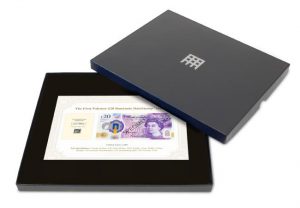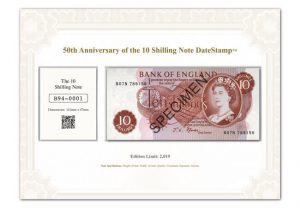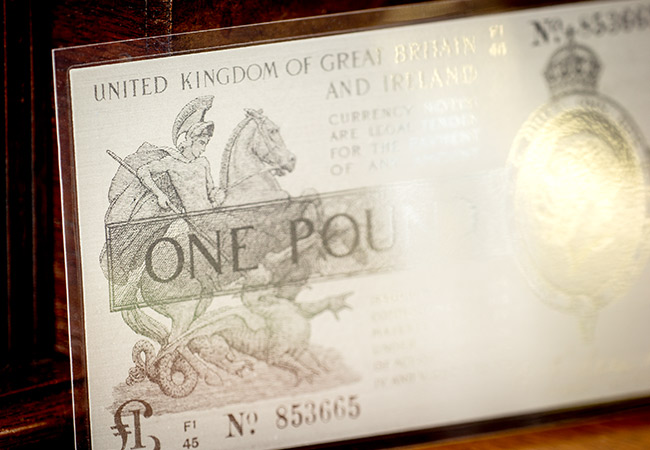Posts Tagged ‘banknote’
The secrets hidden in Britain’s most secure banknote yet
Whether you love them or hate them, it’s fair to say that when the Bank of England issued the very first polymer banknotes, UK currency was revolutionised. As well as refreshing the designs of the notes, these polymer versions were considered a cleaner, safer and stronger alternative.
In 2016 it was the £5 that received the first makeover, and Winston Churchill was selected to feature on the note. Jane Austen soon followed on the £10 note and now, as chosen by the British public, renowned artist JMW Turner graces the new £20 polymer note.
But it’s not only the design that makes this note special. You see, the Bank of England have described this note as the most secure banknote yet. So, I’m of course curious to see what special security features have been worked into the design of our newest banknote…
Britain’s most secure banknote
Before the revolutionary polymer £20 came along, there were over 2 billion £20 paper notes in circulation. The sheer volume of them made the £20 note Britain’s most used, and consequently most forged, banknote.
So it’s understandable that the need to make it difficult to counterfeit was at the forefront of the designer’s mind! The result? A whole host of special features that make it harder to forge and stand out from other notes in circulation.
Let’s take a closer look at some of the security features incorporated into the design:
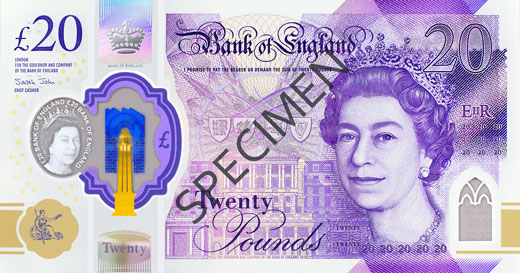
- Transparent windows – the foil in the large see-through window is blue and gold on the front, and silver on the back. Plus, there’s a second, smaller window in the bottom corner.
- Changing holograms – the hologram beneath the large clear pane will alternate between reading ‘Twenty’ and ‘Pounds’ depending on what way you tilt the note.
- The Queen’s portrait in the transparent window – the Queen’s portrait is printed on the window with ‘£20 Bank of England’ printed twice around the edge.
- Foil patches – a silver foil patch contains a 3D image of the coronation crown. There is a second purple foil patch which contains the letter ‘T’.
- Ultra-violet technology – under UV light, the number ’20’ appears in bright red and green on the front of the note, against a duller background.
- Raised dots – you’ll find three clusters of raised dots in the top left hand corner. This tactile feature helps blind and partially sighted people identify the value of the note.
JMW Turner design
When choosing the design for the £20 note, the Bank of England were spoilt for choice. They received over 29,000 nominations submitted by the general public. And the choice to select JMW Turner makes him the first British artist to ever feature on a UK banknote.
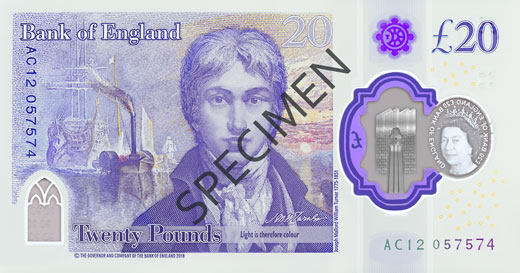
The note itself features Turner’s 1799 self-portrait, which is currently housed in the Tate Modern in London. And behind this you’ll notice one of his most recognisable works – The Fighting Temeraire. This famous painting is a tribute to the ship that played a pivotal role in in Nelson’s victory at the Battle of Trafalgar in 1805.
The final nod to Turner in the design comes from the quote “light is therefore colour”, alongside the signature taken from his will. The quote is taken from a lecture Turner gave in 1818 and is a reference to his innovative use of light, shade, colour and tone.
What do you think about the new £20 Polymer note? Let us know in the comments!
If you’re interested…
If you’re looking for a way to own this significant, revolutionary piece of British currency, then look no further than the UK 2020 £20 Polymer Banknote DateStamp™ issue. Each DateStamp™ issue has been postmarked by Royal Mail with the note’s first day of release – 20th February 2020 – forever ensuring its provenance.
First issues are always valued by collectors and by owning the DateStamp™ issue you will be one of just 2,500 collectors able to forever mark the date the new £20 polymer banknote entered circulation. We have a limited number available, so click here to find out more >>
The fascinating history of the ‘Ten Bob’ banknote…
The 10 Shilling Note, or ‘ten bob’, was a goodly sum in the old days – in the 1960’s it could buy 6 pints of beer, 10 loaves of bread, or 17 pints of milk.
It’s hard to imagine its decimal equivalent, the 50p, buying so much these days!
This old banknote has a fascinating history, from being issued by the Government in a wartime emergency, changing colour to avoid forgery from the Nazis and eventually being replaced by the world’s most popular coin.
The Emergency Banknote
In August 1914, the British economy was in turmoil because of the instability brought on by the oncoming war on the continent. Bankers and politicians were desperately looking for ways to secure Britain’s finances and prevent the banks from collapsing.

The Government decided that a large supply of banknotes had to be made available for the value of 10 shillings, making it easy for the public to make small transactions. However, The Bank of England was not able to prepare and print the required number of notes quickly enough, so the Government took the unprecedented step of deciding to issue the notes itself.
These banknotes became known as the Treasury banknotes and were unlike anything the British public had ever seen. Until this point the lowest denomination banknote was £5, and in those days this was such a large sum that many people would never have seen or used a banknote before.
That means that these Treasury notes now stand out as the first widely circulated banknotes in England.
The Wartime colour change
In 1928, the responsibility for printing Ten Shilling Notes was transferred to the Bank of England.
However, not long afterwards Britain once again found itself at war, and again found its currency under threat.
During World War II, Nazi Germany hatched a plan to undermine British currency. Through Operation Bernhard they believed that they had discovered a method to manufacture counterfeit ‘White Fivers’ and planned to distribute these in huge numbers to destabilise the British currency.

The Bank of England decided to take preventative action and, as a result, the 10 Shilling note was changed for duration of the war to a distinctive pink and blue in an attempt to prevent counterfeiting. It was also revolutionary in the progression of banknote technology by incorporating a metal security thread.
The Nazis could not compete with this high level anti-forgery technology and hence the British 10 Shilling Note stayed strong and supported the British wartime economy as it had done since its conception.
The 50p revolution
After undergoing a colour change during the Second World War, the ‘ten bob’ note reverted to the familiar red-brown until 1961, when a new design featuring a portrait of Queen Elizabeth II was introduced.
Despite a new design for the 10 Shilling Note featuring Sir Walter Raleigh on the reverse being approved in 1964, as part of the process of decimalisation it was dropped in favour of the new fifty pence coin introduced in 1969.
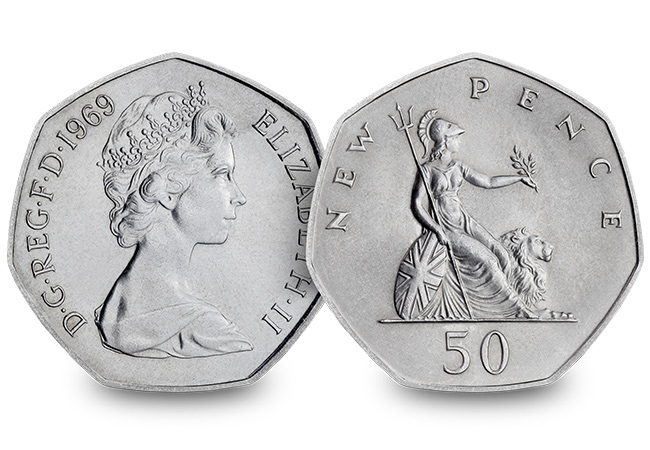
The principle reason for the change was to save the treasury money, the notes had an average lifetime of around five months, whereas a coin could last for fifty years. The 50p has since gone on to become the world’s most popular and collected coin, but nowadays few realise the fascinating history of its predecessor, the 10 Shilling Banknote!
If you’re interested…
It’s now been 50 years since the last 10 Shilling Banknote was issued – which is why you now have the chance to pay tribute to this famous old note with a LIMITED EDITION DateStamp™. But only a very limited number of 10 Shilling Notes will be released in this way, so you’ll need to be quick if you want to secure one for your collection! Click here to order one today >>
The longest bank holiday in British history…
In August 1914, the British economy was in turmoil because of the instability brought on by the oncoming war on the continent. Bankers and politicians were desperately looking for ways to secure Britain’s finances and prevent the banks from collapsing.
So to buy time to look for a solution, the government extended the national bank holiday on 3rd August to include Tuesday 4th, Wednesday 5th and Thursday 6th August – making this the longest bank holiday in British history!
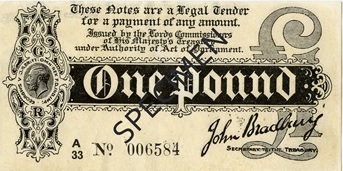
The government decided that a large supply of banknotes had to be made available for the values of £1 and 10 shillings, making it easy for the public to make small transactions and to dissuade the hoarding of precious metal coins. However, The Bank of England was not able to prepare and print the required number of notes quickly enough, so the government took the unprecedented step of deciding to issue the notes itself.
These banknotes became known as the Treasury banknotes and were unlike anything the British public had ever seen. Until this point the lowest denomination banknote was £5, and in those days this was such a large sum that many people would never have seen or used a banknote before.
That means that these Treasury notes now stand out as the first widely circulated banknotes in England.

And what’s more, the Treasury notes featured a portrait of King George V. Nowadays we’re used to seeing Her Majesty on our banknotes, but the Treasury notes were the first British notes to feature a portrait of the monarch. In fact, Bank of England notes would not display an image of the monarch until 1960.
Treasury notes played a vital role in keeping the economy moving during the First World War and for the first time in England and Wales, paper money became normal currency used by ordinary people.
These notes were born out of Britain’s longest bank holiday and now stand as some of the most interesting banknotes in notaphily history!
If you’re interested…
Today you have the opportunity to own a FINE SILVER reproduction of the 3rd issue Treasury Note. Act now to secure this perfect banknote commemorative.
Click here to order your FINE SILVER reproduction Treasury Note now >>>

